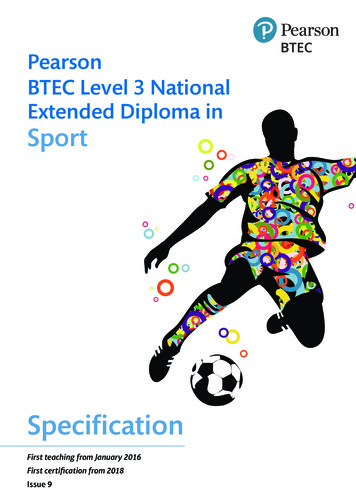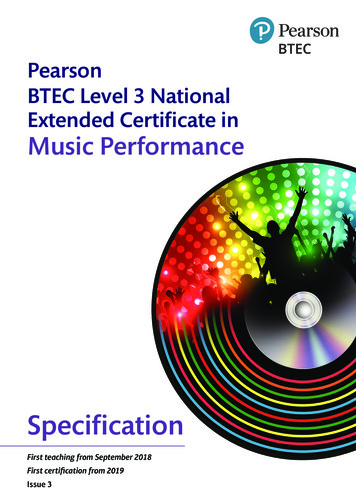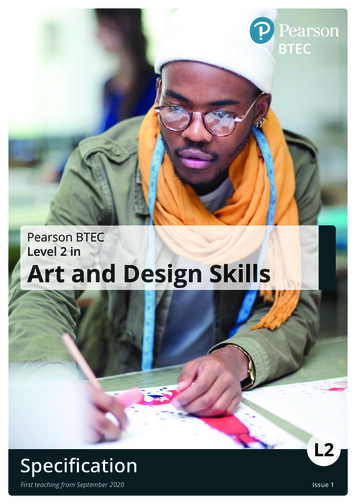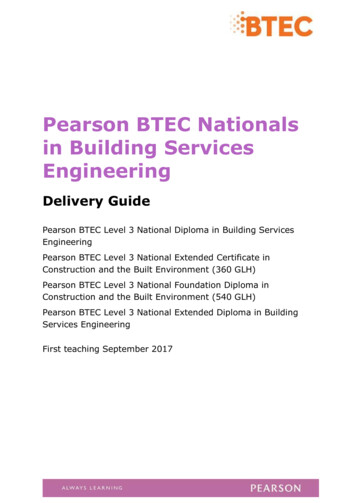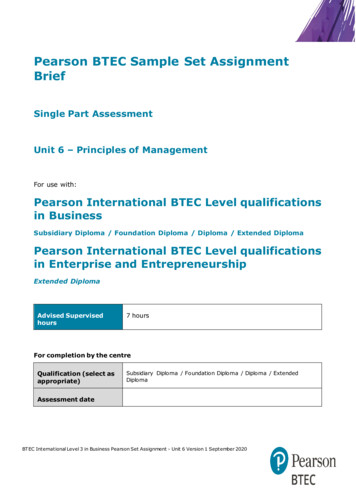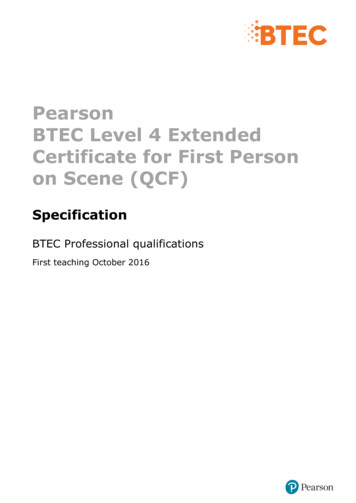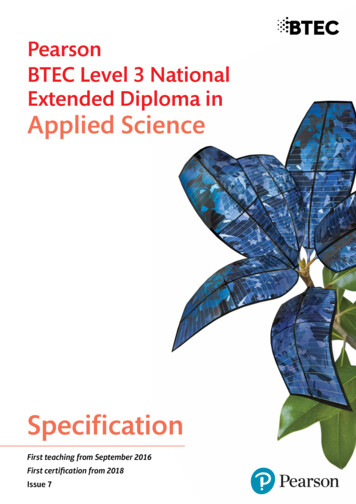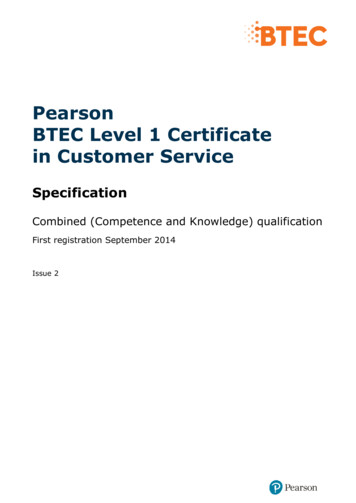
Transcription
PearsonBTEC Level 1 Certificatein Customer ServiceSpecificationCombined (Competence and Knowledge) qualificationFirst registration September 2014Issue 2
Edexcel, BTEC and LCCI qualificationsEdexcel, BTEC and LCCI qualifications are awarded by Pearson, the UK’s largest awardingbody offering academic and vocational qualifications that are globally recognised andbenchmarked. For further information, please visit our qualifications website atqualifications.pearson.com. Alternatively, you can get in touch with us using the details onour contact us page at qualifications.pearson.com/contactusAbout PearsonPearson is the world's leading learning company, with 35,000 employees in more than 70countries working to help people of all ages to make measurable progress in their livesthrough learning. We put the learner at the centre of everything we do, because whereverlearning flourishes, so do people. Find out more about how we can help you and yourlearners at qualifications.pearson.comThis specification is Issue 3. Key changes are listed in the summary table on the next page.We will inform centres of any changes to this issue. The latest issue can be found on thePearson website: qualifications.pearson.com.This qualifications was previously known as:Pearson BTEC Level 1 Certificate in Customer Service (QCF)The QN remains the same.References to third party material made in this specification are made in good faith. Pearsondoes not endorse, approve or accept responsibility for the content of materials, which may besubject to change, or any opinions expressed therein. (Material may include textbooks,journals, magazines and other publications and websites.)All information in this specification is correct at time of publication.ISBN 978 1 446 93922 2All the material in this publication is copyright Pearson Education Limited 2017
Summary of Pearson BTEC Level 1 Certificate in CustomerService specification Issue 2 changesSummary of changes made between previous issue and thiscurrent issuePage numberAll references to QCF have been removed throughout the specificationDefinition of TQT added2Definition of sizes of qualifications aligned to TQT3TQT value added4GLH range removed and replaced with lowest GLH value for theshortest route through the qualification4Earlier issue shows previous changes.If you need further information on these changes or what they mean, contact us via our websiteat: tml.
ContentsPurpose of this specification11 Introducing Pearson BTEC Combined (Competenceand Knowledge) qualifications2What are Combined (Competence and Knowledge) qualifications?22Qualification summary and key information43Qualification rationale5Qualification objectives5Relationship with previous qualifications5Progression opportunities5Industry support and recognition6Relationship with National Occupational Standards6Qualification structure7Pearson BTEC Level 1 Certificate in Customer Service7Programme delivery9Elements of good practice9Learner recruitment, preparation and support945678Training and assessment delivery10Employer engagement11Delivery guidance for Pearson BTEC Level 1 Certificate in CustomerService11Centre resource requirements14Specific resource requirements14Access and recruitment15Prior knowledge, skills and understanding15Access to qualifications for learners with disabilities or specific needs15Assessment16Language of assessment16Competence units16Assessment strategy17Types of evidence18Knowledge units19
9Appeals19Dealing with malpractice20Reasonable adjustments to assessment20Special consideration20Centre recognition and approval21Centre recognition21Approvals agreement2110 Quality assurance of centres2211 Unit format23Unit title23Unit reference number23Credit value23Guided learning hours23Unit summary23Learning outcomes23Assessment criteria23Unit amplification24Information for tutors24Unit 1:Understand Working in a Customer Service Environment25Unit 2:Communication in Customer Service34Unit 3:Principles of Personal Performance and Development40Unit 4:Principles of Working in a Business Environment48Unit 5:Work with Others in a Business Environment56Unit 6:Record Details of Customer Service Problems62Unit 7:Deal with Customer Queries, Requests and Problems67Unit 8:Communicate with Customers in Writing73Unit 9:Deal with Incoming Telephone Calls from Customers78Unit 10:Make Telephone Calls to Customers85Unit 11:Process Information about Customers92Unit 12:Manage Time and Workload97Unit 13:Meet and Welcome Visitors in a Business Environment102Unit 14:Contribute to Sales Activities in a Contact Centre107Unit 15:Use Specific Features of Contact Centre Systems andTechnology112Health and Safety Procedures in the Workplace119Unit 16:
Unit 17:Processing Sales Orders124Unit 18:Meeting Customers’ After Sales Needs13112 Further information and useful publications13513 Professional development and training13614 Contact us138Annexe A: Skills CFA Assessment Strategy forCompetence units (S/NVQ) in Business Administration,Customer Service and Management and Leadership139Annexe B: Skills CFA Contact Centres OperationsAssessment Strategy147Annexe C: Skills CFA Sales Assessment Strategy149
Purpose of this specificationThis specification sets out: the objectives of the qualification the combination of units that a learner must have completed before thequalification will be awarded and any pathways any other requirements that a learner must have satisfied before they will beassessed or before the qualification will be awarded the knowledge, skills and understanding that will be assessed as part of thequalification the method of any assessment and any associated requirements relating to it the criteria against which a learner’s level of attainment will be measured (suchas assessment criteria) assessment requirements and/or evidence requirements required as specified bythe relevant Sector Skills Council/Standards Setting Body assessment requirements/strategy as published by the relevant Sector SkillsCouncil/Standards Setting Body.Pearson BTEC Level 1 Certificate in Customer Service –Specification – Issue 2 – April 2017 Pearson Education Limited 20171
1Introducing Pearson BTEC Combined(Competence and Knowledge) qualificationsWhat are Combined (Competence and Knowledge)qualifications?A Combined (Competence and Knowledge) qualification is a work-basedqualification that combines competence and technical knowledge to give learnersthe practical competencies, technical skills and sector-related knowledge they needto be able to carry out a job effectively.Combined (Competence and Knowledge) qualifications are based on the NationalOccupational Standards (NOS) for the appropriate sector. NOS define whatemployees, or potential employees, must be able to do and know, and how wellthey should undertake work tasks and work roles. At Level 2 and above, thesequalifications are recognised as the competence component of ApprenticeshipFrameworks. Qualifications at Level 1 can be used in Traineeships, which arestepping-stones to Apprenticeship qualifications. Combined (Competence andKnowledge) qualifications can also be delivered as stand-alone for those who wishto take a work-based qualification.Combined (Competence and Knowledge) qualifications are outcome based with nofixed learning programme – allowing flexible delivery that meets the individuallearner’s needs. They are suitable for those in employment and for those studyingat college who have a part-time job or access to a substantial work placement sothat they are able to demonstrate the competencies that are required for work.Most learners will work towards their qualification in the workplace or in settingsthat replicate the working environment as specified in the assessmentrequirements/strategy for the sector. Colleges, training centres and employers canoffer these qualifications provided they have access to appropriate physical andhuman resources.Total Qualification Time (TQT)For all regulated qualifications, Pearson specifies a total number of hours that it isestimated learners will require to complete and show achievement for thequalification – this is the Total Qualification Time (TQT). The TQT value indicatesthe size of a qualification.Within the TQT, Pearson identifies the number of Guided Learning Hours (GLH) thatwe estimate a centre delivering the qualification might provide. Guided learningmeans activities, such as lessons, tutorials, online instruction, supervised study andgiving feedback on performance, that directly involve tutors and assessors inteaching, supervising and invigilating learners. Guided learning includes the timerequired for learners to complete external assessment under examination orsupervised conditions.In addition to guided learning, other required learning directed by tutors orassessors will include private study, preparation for assessment and undertakingassessment when not under supervision, such as preparatory reading, revision andindependent research.2Pearson BTEC Level 1 Certificate in Customer Service–Specification – Issue 2 – April 2017 Pearson Education Limited 2017
TQT is assigned after consultation with employers and training providers deliveringthe qualifications.There are three sizes of Combined (Competence and Knowledge) qualifications: Award – a qualification with a TQT value of 120 or less(equivalent to a range of1–12 credits) Certificate – a qualification with a TQT value in the range of 121–369(equivalent to a range of 13–36 credits) Diploma – a qualification with a TQT value of 370 or more(equivalent to 37 credits and above).Pearson BTEC Level 1 Certificate in Customer Service –Specification – Issue 2 – April 2017 Pearson Education Limited 20173
2Qualification summary and key informationQualification titlePearson BTEC Level 1 Certificate inCustomer ServiceQualification Number (QN)601/3392/2Regulation start date28/05/2014Operational start date01/09/2014Approved age ranges14-1616-1819 Please note that sector-specific requirements orregulations may prevent learners of a particularage from embarking on this qualification. Pleaserefer to the qualification Assessment Strategy inAnnexe A.Credit value23AssessmentPortfolio of Evidence (internal assessment).Total Qualification Time (TQT)230Guided learning hours143Grading informationThe qualification and units are graded pass/fail.Entry requirementsNo prior knowledge, understanding, skills orqualifications are required before learnersregister for this qualification. However, centresmust follow the Pearson Access and Recruitmentpolicy (see Section 7, Access and Recruitment).Centres will need to use the Qualification Number (QN) when they seek publicfunding for their learners. As well as a QN, each unit within a qualification has aunit reference number (URN).The qualification title, unit titles and QN will appear on each learner’s finalcertificate. Centres should tell learners this when recruiting them and registeringthem with Pearson. There is more information about certification in ourUK Information Manual, available on our website at: qualifications.pearson.com4Pearson BTEC Level 1 Certificate in Customer Service–Specification – Issue 2 – April 2017 Pearson Education Limited 2017
3Qualification rationaleQualification objectivesThe Pearson BTEC Level 1 Certificate in Customer Service is for learners who workin, or who want to work in a supporting role in the customer service sector. It issuitable for learners who have little or no previous experience of the sector,including those returning to work after unemployment, NEET learners and schoolleavers.It gives learners the opportunity to: develop and demonstrate skills, knowledge and attitudes for working in acustomer service role, carrying out a range of routine service-related tasksincluding communicating and dealing directly with customers develop their own personal growth and engagement in learning through thedevelopment of personal, learning and thinking skills (PLTS) have existing skills recognised achieve a nationally-recognised Level 1 qualification.Relationship with previous qualificationsThis qualification is a direct replacement for the Pearson Edexcel Level 1 Certificatein Customer Service (QCF), which expired in September 2014, and the PearsonBTEC Level 1 Award in Customer Service (QCF), which expired in December 2014.Progression opportunitiesLearners who achieve the Pearson BTEC Level 1 Certificate in Customer Service canprogress to the Intermediate Apprenticeship in Customer Service at Level 2, whichincludes the Pearson BTEC Level 2 Diploma in Customer Service or to a Level 2qualification such as the following: Pearson BTEC Level 2 Award in Principles of Customer Service) Pearson BTEC Level 2 Certificate in Principles of Customer Service (Learners could also progress to employment in customer service in a supportingrole, for example: Customer Service Assistant Telesales Operative Help Desk Assistant Call Centre Advisor.The Pearson BTEC Level 1 Certificate in Customer Service includes a number ofBusiness and Administration units in its structure, providing a potential foundationfor future study in this subject area.Pearson BTEC Level 1 Certificate in Customer Service –Specification – Issue 2 – April 2017 Pearson Education Limited 20175
Industry support and recognitionThis qualification is supported by Skills CFA, the Sector Skills Council for pan-sectorbusiness skills, which includes the customer service sector.Relationship with National Occupational StandardsThis qualification is based on the National Occupational Standards (NOS) inCustomer Service, which were set and designed by Skills CFA, the Sector SkillsCouncil for the sector.6Pearson BTEC Level 1 Certificate in Customer Service–Specification – Issue 2 – April 2017 Pearson Education Limited 2017
4Qualification structurePearson BTEC Level 1 Certificate in Customer ServiceThe learner will need to meet the requirements outlined in the table below beforethe qualification can be awarded.Minimum number of credits that must be achieved23Number of mandatory credits that must be achieved from Group A14Minimum number of optional credits that must be achieved (either fromGroup B only, or from both Group B and Group C)9Minimum number of optional credits that must be achieved from Group B6Maximum number of optional credits that may be achieved from Group C3UnitUnitreferencenumberGroup A: Mandatory rstand Working in aCustomer Service Environment13252Y/506/2085Communication in CustomerService12143L/506/1791Principles of Personal Performanceand Development13304R/506/1792Principles of Working in aBusiness Environment14255Y/506/1793Work with Others in a p B: Optional rd Details of CustomerService Problems13147A/506/2113Deal with Customer Queries,Requests and Problems13118T/506/2126Communicate with Customers inWriting23209H/506/2154Deal with Incoming TelephoneCalls from Customers231610K/506/2155Make Telephone Calls toCustomers231611R/506/2134Process Information aboutCustomers2314Learners must achieve all 14credits from this group.Learners must achieve a minimumof 6 credits from this group.Pearson BTEC Level 1 Certificate in Customer Service –Specification – Issue 2 – April 2017 Pearson Education Limited 20177
UnitUnitreferencenumberGroup C: Optional age Time and Workload111013A/506/1799Meet and Welcome Visitors in aBusiness Environment122014F/503/0392Contribute to Sales Activities in aContact Centre13615F/503/0361Use Specific Features of ContactCentre Systems and Technology131216T/505/4673Health and Safety Procedures inthe Workplace221617M/502/8587Processing Sales Orders221718R/502/8601Meeting Customers’ After SalesNeeds23148Learners may achieve a maximumof 3 credits from this group.Pearson BTEC Level 1 Certificate in Customer Service–Specification – Issue 2 – April 2017 Pearson Education Limited 2017
5Programme deliveryCentres are free to offer these qualifications using any mode of delivery, forexample full time, part time, evening only, distance learning, that meets learners’needs. Learners must be in employment or working with a training provider on aprogramme so that they can develop and demonstrate the occupational competencerequired.Whichever mode of delivery is used, centres must make sure that learners haveaccess to specified resources and to the sector specialists delivering and assessingthe units. Centres must adhere to the Pearson policies that apply to the differentmodes of delivery, in particular the policy Collaborative Arrangements for theDelivery of Vocational Qualifications on our website at www.edexcel.com/policiesThere are various approaches to delivering a successful competence-basedqualification. The section below outlines elements of good practice that centres canadopt in relation to learner recruitment, preparation and support, training andassessment delivery, and employer engagement.Elements of good practiceLearner recruitment, preparation and supportGood practice in relation to learner recruitment, preparation and support includes: providing initial advice and guidance, including work tasters, to potentiallearners to give them an insight into the relevant industry and the learningprogramme using a range of appropriate and rigorous selection methods to ensure thatlearners are matched to the programme best suited to their needs carrying out a thorough induction for learners to ensure that they completelyunderstand the programme and what is expected of them. The induction caninclude, for example, the requirements of the programme, an initial assessmentof current competency levels, assessment of individual learning styles,identification of training needs, an individual learning plan, details of trainingdelivery, the assessment process. It is good practice to involve employers in theinduction process, this helps them to understand what will be taking placeduring the programme and enables them to start building a relationship with thecentre to support the effective delivery of the programme keeping in regular contact with the learner to keep them engaged andmotivated, and ensuring that there are open lines of communication with thelearner, the assessor, the employer and teaching staff.Pearson BTEC Level 1 Certificate in Customer Service –Specification – Issue 2 – April 2017 Pearson Education Limited 20179
Training and assessment deliveryGood practice in relation to training and assessment delivery includes: offering flexible delivery and assessment to meet the needs of the employer andlearner, through the use of a range of approaches, for example virtual learningenvironments (VLEs), online lectures, video, printable online resources, virtualvisits, webcams for distance training, e-portfolios balancing on-the-job and off-the-job training to meet the knowledge andcompetence requirements of the programme:ooff-the-job: the nature of Combined (Competence and Knowledge)qualifications means that the development of technical- and sector-relatedknowledge is integral to learners achieving them. As a result, learners needto have sufficient time away from the work environment to focus ondeveloping their technical and industry knowledge, and transferable andpractical skills related to their job role. Tutors need to use a range ofteaching and learning methods to deliver this training effectively, forexample demonstration, observation and imitation, practising (‘trial anderror’), feedback on performance from experts and peers, reflective practice,real-world problem solving, enquiry-based learning, simulation and roleplay, peer learning, virtual environments, questioning, discussionsoon-the-job: planning opportunities with the employer for the developmentand practising of skills on the job. The on-the-job element of the programmeoffers opportunities for assessment and plays an important role indeveloping the learner’s routine expertise, resourcefulness, craftspersonshipand business-like attitude. It is important that there is intentionalstructuring of practice and guidance to supplement the learning anddevelopment provided through engagement in everyday work activities.Teaching and learning methods, such as coaching, mentoring, shadowing,reflective practice, collaboration and consultation, could be used in thisstructured on-the-job learning developing a holistic approach to assessment by matching evidence to differentassessment criteria, learning outcomes and units as appropriate, therebyreducing the assessment burden on learners and assessors. It is good practiceto draw up an assessment plan that aligns the units with the learning processand the acquisition of knowledge and skills, and which indicates how and whenthe units will be assessed. In producing the plan, the assessor should workclosely with the learner to identify any activities that relate to more than oneunit or learning outcome and to agree the best way to collect a single piece ofevidence that meets the assessment requirements sufficiently. The assessmentguidance given in the units identifies opportunities to assess units holistically,helping centres to develop assessment plans discussing and agreeing with the learner and employer suitable times, dates andwork areas where assessment will take place. Learners and employers should begiven regular and relevant feedback on performance and progress.10Pearson BTEC Level 1 Certificate in Customer Service–Specification – Issue 2 – April 2017 Pearson Education Limited 2017
Employer engagementGood practice in relation to employer engagement includes: communicating with employers at the start of the programme to understandtheir business context and requirements so that the programme can be tailoredto meet their needs working with the employer to ensure that learners are allocated a mentor in theworkplace to assist them in the day-to-day working environment and to act as acontact for the assessor/tutor helping the employer to better understand their role in the delivery of theprogramme. It is important that employers understand that sufficient andrelevant work must be given to learners in order to provide a culture of learningand to ensure that they are given every opportunity to participate in aspects ofcontinuous professional development (CPD).Delivery guidance for Pearson BTEC Level 1 Certificate inCustomer ServiceThe following delivery guidance is not intended to be prescriptive. Those deliveringthe programme of learning can adapt the guidance to meet the needs of learners,employers and the specific context.This qualification comprises both practical and knowledge-based units. Themandatory units cover knowledge requirements and underpin the practical elementsof the qualification. Delivery of the mandatory units can involve a wide range ofmethods, including: presentations – covering key legislation surrounding roles in customer service,the standards required in a customer service role in a business environment,personal development, and key aspects of communication and how these mayaffect the level of customer service provided discussion – class and small group discussions focusing on particular aspects ofa role in a customer service environment role play – for example, answering telephone calls, examples of good and badcustomer service, and dealing with customers within scenarios from differentindustries or settings.Group work is also a valid method of delivery, but it should be remembered thatwhen being assessed, learners must produce individual pieces of work clearlyshowing that the relevant assessment criteria have been met.Many of the units overlap in their content and complement each other, allowingdelivery to take place holistically, covering several parts of units or criteria at thesame time.Pearson BTEC Level 1 Certificate in Customer Service –Specification – Issue 2 – April 2017 Pearson Education Limited 201711
Delivery of this qualification would benefit from access to a workplace wherelearners have the opportunity to demonstrate the skills required in a customerservice environment. Units could be linked and delivered holistically, for exampleUnit 2: Communication in Customer Service could be taught in conjunction withUnit 7: Deal with Customer Queries, Requests and Problems, Unit 8: Communicatewith Customers in Writing, Unit 9: Deal with Incoming Telephone Calls fromCustomers, or Unit 10: Make Telephone Calls to Customers. Delivering these unitsholistically would give learners the opportunity to reinforce learning which haspreviously taken place in the classroom, allowing them to link together keycustomer service concepts and aspects of working in a customer serviceenvironment. Learners could gain experience in communicating with both internaland external customers in a business environment, allowing them to recogniseopportunities to contribute to the business in a positive way by delivering goodcustomer service.An alternative delivery method would be for learners to undertake a workplacement or work experience in an appropriate environment where customerservice is a key part of the role. This will allow learners to develop the skillsrequired, especially in the area of communication. Learners could benefit from theopportunity to experience different types of customer service, for example theycould work in an office environment (call centre) or in the retail or hospitalitysector.For the practical units demonstration could be used, particularly for the use ofequipment such as telephone systems and payment systems. Tutors could also userole play, particularly in the use of telephones, where one learner could be acustomer with the other acting as a customer service adviser, taking calls anddealing with customer queries and complaints. This method of delivery could coverseveral units, including Unit 2: Communication in Customer Service, Unit 9: Dealwith Incoming Telephone Calls from Customers and Unit 10: Make Telephone Callsto Customers. Tutors could write a short scenario or brief for learners and learnerscould create their own script for answering the telephone in the correct mannerbefore reflecting on their performance after the role play has been completed.Visiting speakers working at different levels in customer service could add value tothe delivery of this qualification. Speakers could be given time to discuss withlearners what is expected of a customer service representative and how the role canbe developed, so that learners can strive to develop their skills in order to furthertheir career. Speakers could also focus on different customer service roles in thesector and the industries where customer service is of particular importance. Linkscould be made with Unit 1: Understand Working in a Customer Service Environmentand Unit 3: Principles of Personal Performance and Development. Tutors coulddirect speakers to ensure that key concepts are covered during the visit.Learners could be given an opportunity to interview a practitioner currentlyemployed by a local organisation in a customer service role, allowing learners to askkey questions about the role, looking at a typical role on a day-to-day basis andlooking at the contribution that a customer service representative makes to theoverall organisation. Learners could work in small groups developing key questionsto ask the speaker and recording their answers during the discussion. Tutors couldalso direct learners in this activity so that key concepts are covered. This could linkwith several units, for example Unit 8: Communicate with Customers in Writing,Unit 11: Process Information About Customers, Unit 17: Processing Sales Ordersand Unit 18: Meeting Customers' After Sales Needs.12Pearson BTEC Level 1 Certificate in Customer Service–Specification – Issue 2 – April 2017 Pearson Education Limited 2017
The use of case studies focusing on well-known organisations could also be used todeliver this qualification, and could help tutors to highlight the differences betweengood and bad customer service, linking with Unit 2: Communication in CustomerService. Tutors could also consider using scenario-based briefs to allow learners tocarry out role play exercises covering key customer service activities.Pearson BTEC Level 1 Certificate in Customer Service –Specification – Issue 2 – April 2017 Pearson Education Limited 201713
6Centre resource requirementsAs part of the approval process, centres must make sure that the resourcerequirements below are in place before offering the qualification. Centres must have the appropriate physical resources to support delivery andassessment of the qualification. For example, a workplace in line with industrystandards, or a Realistic Working Environment (RWE), where permitted, asspecified in the assessment requirements/strategy for the sector, equipment, IT,learning materials, teaching rooms. Where RWE is permitted, it must offer the same conditions as the normalday-to-day working environment, with a similar range of demands, pressuresand requirements for cost-effective working. Centres must meet any specific human and physical resource requirementsoutlined in the Skills CFA assessment strategy in Annexe A. Staff assessinglearners must meet the occupational competence requirements within theoverarching assessment requirements/strategy for the sector. There must be systems in place to ensure continuing professional developmentfor staff delivering the qualification. Centres must have appropriate health and safety policies, procedures andpractices in place for the delivery and assessment of the qualification. Centres must deliver the qualification in accordance with current equalitylegislation. For further details on Pearson’s commitment to the EqualityAct 2010, please see
in Customer Service (QCF), which expired in September 2014, and the Pearson BTEC Level 1 Award in Customer Service (QCF), which expired in December 2014. Progression opportunities Learners who achieve the Pearson BTEC Level 1 Certificate in Customer Service can progress to the Intermediate Apprenticeship in Customer Service at Level 2, which
